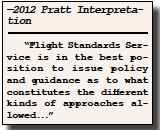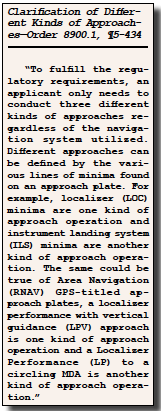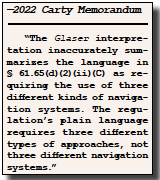In “Which Three Approaches?” (September 2022 IFR) we discussed the FAA Chief Counsel’s abandonment of earlier restrictive interpretations of the dual cross-country prerequisite for the instrument rating. The flight, described in §61.65(d)(2)(ii) of the FAA regulations must include “three different kinds of approaches with the use of navigation systems.”
The 2008 Glaser and the 2012 Pratt letters interpreted this as a requirement to use approaches with “three different kinds of navigation systems.” The FAA is moving relentlessly from a system of ground-based navaids to one using RNAV/GPS as the primary means of navigation. VOR and NDB approaches are disappearing through the Minimum Operational Network removal of VOR and the related decertification of redundant and little-used ground-based approaches. This led to problems.
At the extreme, pilot examiners have been known to reject applicants who followed the glideslope to a 200-foot ILS decision altitude (DA) at one airport and to a nonprecision 600-foot minimum descent altitude (MDA) at another, since they both use the same kind of navaid—a localizer.
Carty Memorandum
In February 2022, the Chief Counsel published a memorandum to Robert C. Carty, the Acting Executive Director of Flight Standards, rescinding both Glaser and Pratt.
The Carty memo left the question open. If not different types of lateral navaids, what differentiates the “three different kinds of approaches”? The Chief Counsel handed off the ball. “Flight Standards Service (AFS) is in the best position to issue policy and guidance on what ‘navigation systems’ mean and which ones may be used under §61.65(d)(2)(ii)(C).”
Flight Standards to the Rescue
At the time the September IFR went to press, Flight Standards was actively working on answering that question. The answer arrived in late September in the form of a new paragraph to FAA Order 8900.1, the Flight Standards Information Management System. If we were hoping for an answer that is simple to apply and reflects the realities of modern avionics, that’s what we got.
Stripped to its essence, “different kinds of approaches” for the required dual cross country are defined by the type of approach minimums. A LOC and an ILS are different. An RNAV approach flown to an LPV DA is a different kind of approach from one flown to an LNAV straight-in MDA or to a circling minimum.
This is not license to complete the IFR dual cross-country flight without leaving your local area. The regulation still requires the IFR cross country to cover 250 NM (100 NM for helicopters) along airways or as directed by ATC with an approach at each airport.
area. The regulation still requires the IFR cross country to cover 250 NM (100 NM for helicopters) along airways or as directed by ATC with an approach at each airport.
 The FAA is often accused of having the motto, “We’re not happy until you’re not happy.” It is also subject to comments about how it confuses pilots with unintelligible rules and interpretations. Here is an example of Flight Standards, while still following regulatory requirements, giving simple, clear, and helpful answers—a clear win for all.
The FAA is often accused of having the motto, “We’re not happy until you’re not happy.” It is also subject to comments about how it confuses pilots with unintelligible rules and interpretations. Here is an example of Flight Standards, while still following regulatory requirements, giving simple, clear, and helpful answers—a clear win for all.






Where can one find that change to 8900.1 that is mentioned? What does the paragraph specifically read?